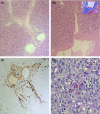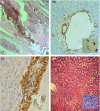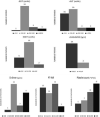Liver histopathology in severe COVID 19 respiratory failure is suggestive of vascular alterations
- PMID: 32654359
- PMCID: PMC7404964
- DOI: 10.1111/liv.14601
Liver histopathology in severe COVID 19 respiratory failure is suggestive of vascular alterations
Abstract
SARS2-CoV-2 breakout in Italy caused a huge number of severely ill patients with a serious increase in mortality. Although lungs seem to be the main target of the infection, very few information are available about liver involvement, possibly evocating a systemic disease. Post-mortem wedge liver biopsies from 48 patients died from severe pulmonary COVID-19 disease with respiratory failure were collected from two main hospitals in northern Italy. No patient had clinical symptoms of liver disease or signs of liver failure before and during hospitalization; for each of them liver function tests were available. All liver samples showed minimal inflammation features. Histological pictures compatible with vascular alterations were observed, characterized by increase in number of portal vein branches associated with lumen massive dilatation, partial or complete luminal thrombosis of portal and sinusoidal vessels, fibrosis of portal tract, focally markedly enlarged and fibrotic. SARS-CoV-2 was found in 15 of 22 samples tested by in situ hybridization method. Our preliminary results confirm the clinical impression that liver failure is not a main concern and this organ is not the target of significant inflammatory damage. Histopathological findings are highly suggestive for marked derangement of intrahepatic blood vessel network secondary to systemic changes induced by virus that could target not only lung parenchyma but also cardiovascular system, coagulation cascade and endothelial layer of blood vessels. It still remains unclear if the mentioned changes are directly related to virus infection or if SARS-CoV-2 triggers a series of reactions leading to striking vascular alterations.
Keywords: SARS-Cov-2 infection and liver biopsy; liver histopathology; liver morphology in COVID 19 disease.
© 2020 John Wiley & Sons A/S. Published by John Wiley & Sons Ltd.
Conflict of interest statement
None.
Figures




References
MeSH terms
LinkOut - more resources
Full Text Sources
Medical
Miscellaneous

